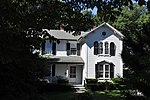East Blackstone Friends Meetinghouse
Buildings and structures in Blackstone, MassachusettsChurches completed in 1812Churches in Worcester County, MassachusettsChurches on the National Register of Historic Places in MassachusettsMassachusetts church stubs ... and 3 more
National Register of Historic Places in Worcester County, MassachusettsQuaker meeting houses in MassachusettsWorcester County, Massachusetts Registered Historic Place stubs

The East Blackstone Friends Meetinghouse (also known as "Mendon Lower Meeting" or "Smithfield Monthly Meeting") is a historic Quaker meetinghouse in Blackstone, Massachusetts. The small single-story wood-frame structure was built in 1812 on land donated to the Quakers by Samuel Smith, a local landowner. The building was used regularly throughout the 19th century for meetings, and sporadically since then.The meeting house was listed on the National Register of Historic Places in 1995.
Excerpt from the Wikipedia article East Blackstone Friends Meetinghouse (License: CC BY-SA 3.0, Authors, Images).East Blackstone Friends Meetinghouse
Elm Street,
Geographical coordinates (GPS) Address Nearby Places Show on map
Geographical coordinates (GPS)
| Latitude | Longitude |
|---|---|
| N 42.0525 ° | E -71.523055555556 ° |
Address
Elm Street 199
01504
Massachusetts, United States
Open on Google Maps










